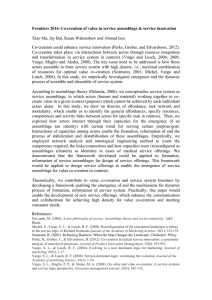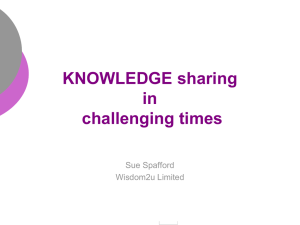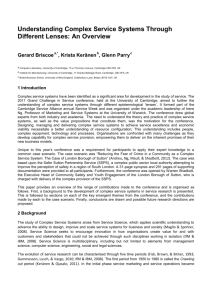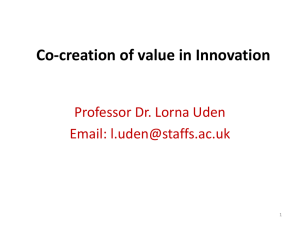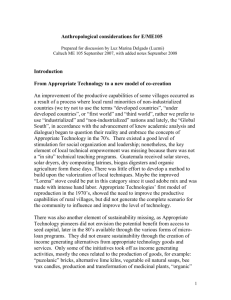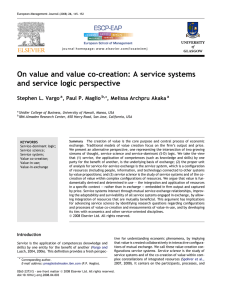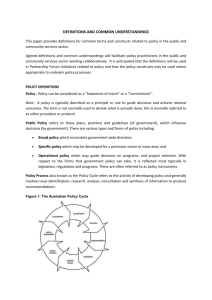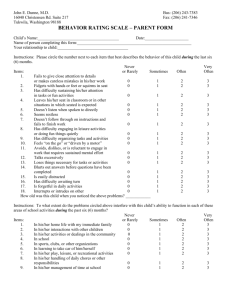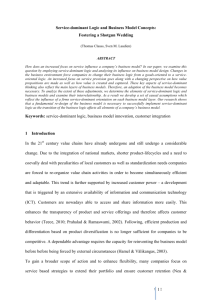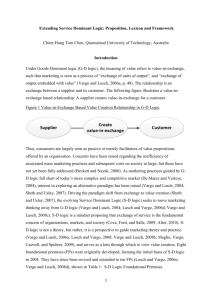When customer value co-creation diminishes value for other
advertisement
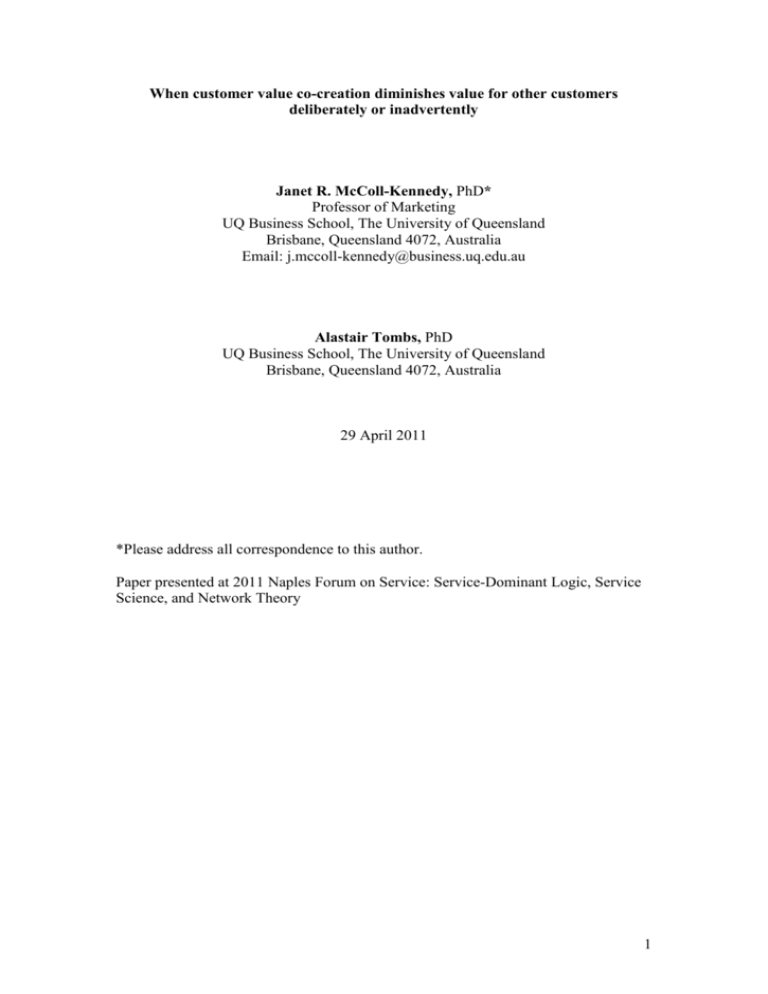
When customer value co-creation diminishes value for other customers deliberately or inadvertently Janet R. McColl-Kennedy, PhD* Professor of Marketing UQ Business School, The University of Queensland Brisbane, Queensland 4072, Australia Email: j.mccoll-kennedy@business.uq.edu.au Alastair Tombs, PhD UQ Business School, The University of Queensland Brisbane, Queensland 4072, Australia 29 April 2011 *Please address all correspondence to this author. Paper presented at 2011 Naples Forum on Service: Service-Dominant Logic, Service Science, and Network Theory 1 Abstract Purpose Drawing on S-D logic, customer-to-customer interaction and dysfunctional customer behaviour literature as well as literature from psychology, this paper develops a theoretical framework to help researchers and managers alike better understand why customers, while co-creating customer value for themselves (1) deliberately and (2) inadvertently, diminish value for other customers present. Methodology/approach Using a grounded theory approach we develop a novel theoretical framework to help us explain these intriguing behaviors. The research is based on in-depth interviews with customers. Findings While we take an S-D logic approach and agree with Foundation Premise (FP) 6 that “the customer is always a co-creator of value”, FP 9 that all “social and economic actors are resource integrators” and PF10 that value is “phenomenologically and contextually determined”(Vargo and Lusch 2004, 2008, Vargo and Akaka 2009), it is important to recognize that customers do not always behave in a manner that enhances value for other customers present in a servicescape, whether actual or virtual. Indeed, as shown by Wirtz and McColl-Kennedy (2010), Harris and Reynolds (2003) and Harris (2008), sometimes customers deliberately take advantage of opportunities to enhance their own wellbeing at the expense of the firm or other customers. As this aspect has not been explored in the literature, our research breaks new ground. Practical implications Our findings provide helpful insights into how customers diminish value for other customers in practice, describing the actual behaviors, drivers and providing explanations designed to help practitioners minimize these potentially damaging behaviors. Practical lessons for managers are provided. Research implications Considerable attention is directed at customer co-creation of value (c.f Gummesson and Mele 2010; Payne, Storbacha and Frow 2008; Ramaswamy and Gouillart 2010), with the focus on the positive aspects of customer value co-creation while the negative aspects are largely neglected. Hence, the present research provides a starting point for further research on the “dark side” (deliberate) and “downside” (inadvertent) of customer value co-creation. Originality/value This is the first study to identify the contexts and provide explanations for why customers sometimes deliberately or inadvertently diminish value for other customers. Furthermore, the research develops theory on customer value co-creation, building further on S-D logic. Keywords: S-D logic, customer value co-creation, customer-to customer Paper type: Research paper 2 When customer value co-creation diminishes value for other customers deliberately or inadvertently Introduction Value co-creation has been variously defined in the literature going back to Normann and Ramirez (1994). We take the view, consistent with an S-D logic perspective, that firms cannot create or deliver value; firms can only offer value propositions (Foundational Premise 7) (Vargo and Lusch 2008a). In other words, value is not created until the beneficiary (i.e. typically the customer) integrates resources from various sources (Vargo and Akaka 2009), that is, through “value-inuse”. We agree with Foundation Premise (FP) 6 that “the customer is always a cocreator of value”, and FP 9 that all “social and economic actors are resource integrators”, and PF10 that value is “phenomenologically and contextually determined”(Vargo and Lusch 2004, 2008, Vargo and Akaka 2009). However, it is important to recognize that customers do not always behave in a manner that enhances value for other customers present in a servicescape, whether actual or virtual. Considerable attention is being directed at customer co-creation of value (c.f Gummesson and Mele 2010; Payne, Storbacha and Frow 2008; Ramaswamy and Gouillart 2010). Surprisingly little empirical research has addressed the customer’s role in value co-creation and its subsequent effect on important customer outcomes. Furthermore, the focus to date has been on the positive side of customer value cocreation. However, although the customer at the center of the co-creation of value may realize benefit, firms, employees of the firms and other customers present may not realize the same benefit, worse still, they may feel that value has been diminished for them either unintentionally or deliberately as a consequence of customer cocreation of value by another party. This is where our paper contributes; - when 3 customer value co-creation diminishes value for other customers deliberately or inadvertently. Value Co-creation First, we need to be clear about what we mean by value co-creation. In S-D logic (Vargo and Lusch 2004, 2008a), value co-creation is accomplished through resource integration. What have traditionally been referred to as the “firm” and the “customer”, are identified as resource integrators; this suggests that each benefits from the service of the other, and the integration of resources. However, customers may integrate resources to achieve benefits from sources other than the firm, such as from within themselves (for example, their own personal knowledge and skill sets), from friends, family, other customers (private sources) (Vargo and Lusch 2011), other firms and the community (Baron and Harris 2008; Arnould, Price, and Malshe 2006). We define customer value co-creation as “the enhancement of customer benefit from integration of resources through activities and interactions with collaborators in the customer‟s service network.” Activities are defined as „performing‟ or „doing‟ (cognitive and behavioral). Interactions are the ways individuals engage with others in their service network to integrate resources. The notion of the customer as an active rather than passive recipient of service is widely acknowledged (c.f. Toffler 1980; Baron and Harris 2008; Payne, Storbacka, and Frow 2008; Xie, Bagozzi, and Troye 2008). In varying degrees, customers play an active role in the provision of service and in the realization of its benefit (co-creation of value) (Prahalad and Ramaswamy 2000; Vargo and Lusch 2004; Tax, Colgate and Bowen 2006). Some customers might be involved in activities that are typically viewed as “firm” activities such as self service (Bowen and Schneider 1985; Mills and Morris 1986), or in providing ideas for improving service (Bettencourt 1997), even in 4 co-designing. As such they may be regarded as „part time employees‟ of the organization. This behavior is defined as customer co-production. While not all customers are involved in co-production activities, it may be argued that all customers are involved to varying degrees through a range of different activities and interactions integrating resources with a range of others primarily with employees and other customers to realize benefit (Arnould, Price, and Malsche 2006; Barron and Harris 2008). Customer value co-creation can take different forms and styles from passive compliance through to team management (McColl-Kennedy et al. 2011). However, customers while realizing benefit for themselves may intentionally or inadvertently diminish value for other customers. Several authors (c.f Fisk et al 2009, Bitner et al 1994 and Lovelock 2001) have demonstrated that some customers appear to deliberately behave badly resulting in negative consequences for employees and other customers. As summarized in Table 1 various terms have been used to describe this negative behavior. Lovelock (2001, 73) coined the term “jaycustomers”, defined as “one‟s who act in a thoughtless or abusive way, causing problems for the firm, its employees and other customers”. Bitner et al (1994, 98) used the term “problem customers” for “customers who are “unwilling to cooperate with the service provider, other customers, industry regulations, and/or laws”. Berry and Seider (2008) identify the actions of “unfair” customers. More recently, Wirtz and McColl-Kennedy (2010, 655) point out that customers “opportunistic behavior”, defined variously as seeking self-interest with guile (c.f. Ping 1993), “taking advantage of opportunities as they arise”, “giving preference to what can be rather than what should be done in a given context, that is, getting away with it, may take several forms. Common forms of opportunistic 5 behavior include intellectual property theft, fake insurance claims, claiming excessively, wardrobing (i.e. the purchase, use and return of clothing (Chu et al 1998; Harris 2008), sending back an item saying that it has been damaged when actually the customer damaged the goods. Other authors such as Harris and Reynolds (2003) argue that customers as well as intentionally, may unintentionally “overtly or covertly” act in a manner that, in some way, disrupts otherwise functional service encounters”. Much is still not understood in terms of why customers engage in this behavior (Fisk et al 2009). Practice Theory Practice Theory helps shed light on activities (or practices) and why individuals engage in various practices, whether helpful or a hindrance to self and others. Practice theory is being applied across several social sciences, including sociology, social economics, psychology, education and marketing. Social practices are key to understanding such that all activities take place within social systems, and that individuals have the potential to learn, adapt and make choices based on their perceptions of their socially constructed world (Giddens 1984). Central to this view is that the only way to understand reality is through asking individuals about their “sense making” activities, that is, what is meaningful to the individuals (Boland 1985). Meaning is linked to social interactions, roles and positions within a social system (Edvardsson, Tronvoll and Gruber 2011). Schau, Munz and Arnould (2009) take a social practice-based theory approach in the context of brand community. While the findings concern brand community, their work highlights the importance of role and the way individuals engage with others. Some individuals may see greater value in engaging in certain activities than others and will have preferences for ways of interacting based on their mental model of their world. 6 Practice theory is based on three forms of practices: exchange, representational and normalizing practices. The central argument in practice theory (c.f. Kjellberg and Helgesson 2006, 2007), is that the way an individual views the world (representational practices) affects the way that individual interacts through accepting or adjusting norms for example, as reflected in interactions with others (normalizing practices) and this affects the way an individual does things (activities) (these practices are termed “exchange or integrating practices”) and these in turn affect representational practices and vice versa. Service Encounter Needs Theory Service Encounter Needs Theory (SENT) proposed by Bradley et al (2010) sheds further light and offers a compelling frame. The set of eight psychosocial needs viewed as central to the theory is particularly relevant to the present study. While past research demonstrates the importance of these needs across multiple domains (Higgins and Pittman 2008; Pittman and Zeigler 2007). SENT examines the role of psychosocial needs in the context of service interactions and identifies emotions as responses to the fulfilment or violation of psychosocial needs. Integral to the theory is that satisfaction (or violation) of these needs gives rise to a range of emotions such as annoyance, frustration, anger, rage, through to joy and delight which in turn affect behaviors. Based on the work of Murray (1938), Cohen, Stotland, and Wolfe (1955) and others, a need is defined as a recurrent concern for a goal state, an inner force that “directs behaviour towards a goal and causes tension when the goal is not satisfied” (Cohen et al. 1955, 291). Individuals are not necessarily fully aware of the state of their needs. Indeed, Murray (1938, 75) notes the realization of a state of need “may simply be the experience of a vague „lack‟ or „pressure‟ giving rise to unrest, 7 uneasiness or dissatisfaction‟. Compared to physical needs, satisfaction of psychosocial needs for immediate survival but satisfaction is important for well-being (Deci and Ryan 2000). Building on classic theories primarily the work of Murray (1938), Bradley et. al identify eight needs relevant to service interactions as follows: (1) need for cognition; (2) need for competence; (3) need for control; (4) need for power; (5) need for justice; (6) need for trust; (7) need to be treated with respect; and (8) need for pleasing relations. Bradley et al (2010) contend that these needs are arranged broadly along a continuum from one end the more utilitarian (needs for cognition, competence, justice and control) to those with a more socioemotional focus (needs for power, respect, trust and pleasing relations) at the other end. When these needs are violated by others, for example, other customers, individuals feel that wellbeing (or benefit) is diminished. To test this theory in a customer to customer setting we undertook depth interviews with customers asking their views and how they felt both when other customers positively contributed to value- co-creation and when other customers diminished value either deliberately or inadvertently. Method Grounded theory aims to build theory from qualitative field data that can then be tested or extended by other researchers (Strauss and Corbin 1998). The approach taken was iterative. That is, initial interviews assisted in identifying research questions and provided a theoretical focus for subsequent interviews. Consistent with this approach, relevant literature including Practice Theory and Service Encounter Needs Theory (SENT), was consulted throughout the process to enrich the emergent theory through dialectical tacking and constant comparison (Strauss and Corbin 1998). 8 Theoretical sampling was employed as it enables the researcher to focus on avenues that can bring about the greatest theoretical return by selecting informants who are in the best position to provide information on the topic (Strauss and Corbin 1998). Interviews were conducted until information redundancy was achieved (Lincoln and Guba 1985). In all, 43 interviews were conducted with 38 participants. The interviews ranged from 50 minutes to 90 minutes. Interviews were audiotaped and then transcribed. Appendix 1 summarizes key characteristics of participants. The aim of the interviews was to investigate what participants actually felt when other customers co-created value and diminished value either deliberately or inadvertently as viewed by the participants. Participants were asked to tell their story in their own words. The interviewer first asked the participants to talk about experiences both positive and negative when other customers impact their experiences in service interactions. Following established procedures, deeper questions asked about their experiences and generated considerable discussion regarding their thoughts, their feelings and actions which in some cases was gently probed (Lincoln and Guba 1985). (For example, participants were asked questions such as “What do you think made you fee like that?”, “Can you explain that in more detail.” “Can you elaborate on that?”) Discussions flowed like a conversation. Data was analysed using open, axial and selective coding. Open coding involves reading the transcript, breaking it down into separate parts and examining each part in detail and comparing for similarities and differences (Strauss and Corbin 1998). Each of the authors analysed the data independently line by line and classified into positive customer value co-creation and diminishing customer value co-creation, distinguishing inadvertent deliberate forms. Following Beverland, Kates, Lindgreen and Chung‟s (2010) lead we applied ground theory criteria for assessing research 9 quality, namely credibility, transferability, dependability, conformability integrity, fit, understanding, generality and control. Findings Four needs were particularly evident in the interviews. These are the need for control, need to be treated with respect, need for pleasing relations, and need for competence. Each is now discussed in turn. Need for control A strong theme evident in the interviews was the need for control by other customers resulting in customers having value diminished. Several forms of need for control were evident including “stage hogging”, that is, where other customers are taking more control than the other customers believe they should, as illustrated by Sarah: I’ve had experiences that there’d be a lady [other customer] saying “get me this size, get me this size, get me this, get me that...” and I’m just standing there “can I just buy this shirt”. I blame the customer really because when I buy stuff I do in intervals, I don’t keep demanding from the person [employee] continuously. I’d just get something okay...wait a few minutes then ask again but if a customer keeps demanding everything...because I’m a waitress myself so I know the feeling of the owner putting you by yourself and you have to do everything and you have to get through that, you have to take the order. (Sarah F19) In a similar way Natalie talks about customers usurping control over other customers by jumping the queue (line) with the result of diminishing value for the customer. If there’s a rude customer like say you are queuing for to try on clothes and they just barged in and all that of course you aren’t too happy but um…yeah. It will be the other customers fault seeing as he is like being so rude when there’s a long queue to the fitting rooms so it’s like common courtesy to follow the queue and all that. (Natalie F21) Lynne spoke about other customers trying to control her by their inappropriate behavior and her actions to avoid value being diminished further by these other customers. She removes herself from the situation by moving out of their way. 10 I’d just move out of the way because they’re controlling me. If I’m all the time looking at them thinking “they are upsetting my night, they are upsetting my night, they are upsetting my night”. They don’t know they are upsetting it. I’m letting them if I stay. They’re controlling me. (Lynne 49) Need to be treated with respect Participants spoke at length about the angst resulting from not being treated with respect by other customers. This lack of respect from other customers‟ actions took several forms, including loud noise from cell phones, excessively loud talking, shouting and being literally pushed around by other customers such as having chairs moved as other customers pushed past in the restaurant or café or in an airplane, and invading one‟s personal space by being too close and leaning into them or even touching them. For example: [cell phones ringing]. They can be very, very loud. They get very loud, very drunk, very quickly. I mean your mood just absolutely dies. …and then it actually ruins your night. You know just one table in the whole place. (Cathy 40) …you are at a table and you are having a quiet-ish sort of night and you’ve got someone at the next table who is really loud and obnoxious and telling dirty jokes and the more he has to drink the louder he’s laughing. That can really ruin you night. (Cassie 30) It was actually an expensive restaurant …But there was a group of people sitting quite close to us with one young man and three or four young women. Our impression was that he was trying to impress the female companions. So he was quite boastful, which was fine, but he had such a piercing voice that, he was not screaming or shouting, but you could not help but listen to his conversation and it did disturb our conversation. …it was just annoying because we could not separate ourselves from the conversation. We just couldn’t figure a way to filter him out so that we could talk without noticing what he was saying. (Marta 50) …my perception is they [customers] use the quiet carriage [of the train] specifically for that quietness. …there were three young girls, I would think mid to late teens, they were playing music quite loudly – very audibly. They were very giggly, very animated in their discussions. This went on for a good 15-20 minutes. The tone of the conversation was probably a touch of embarrassment to it. I suppose I am bringing gender into it but a guy would be hard pressed to get away with it. They were talking about girlfriends in 11 relationships and the boyfriends of the girlfriends. So yeah, it had a bit of a cringe factor to it. I was probably about half way down the carriage from them and it was very audible from where I was sitting so I dare say yes most of the carriage would have been impacted. (Peter M54) A youngish guy. He had a large set of headphones on - a little bit of overflow from that. He was clearly listening to some music but he was also reading from I assume some album notes or something and the end result was he starts singing along to the lyrics and a woman walked probably halfway down the carriage and very politely asked him could he please quieten down, it was a quiet carriage. He actually responded firstly, not aggressively but said it was his right to continue. (Peter M54) Another participant spoke passionately about a customer in a bank blowing in her ear as she waited to be served, clearly an invasion of privacy by the other customer. I was in the line at the bank one day and it was long line and there was a guy behind me who started blowing in my ear behind me and I looked back and he just looked straight back. I look round and he started blowing in my ear again and it just kept on annoying me. I didn’t...because I was in the middle line I had people behind me, people in front of me...I was waiting for 15 minutes already so it was like no I can’t leave because I really needed to do my banking. …it was uncomfortable having this guy blowing in my ear for no reason. …I wanted to leave and he was really creeping me out. (Sarah F19) Additionally, customers spoke about other customers using bad language, making lewd remarks or telling dirty jokes as illustrated by Stephanie and Gareth. You go there and there is someone behaving raucously. That’s just the most appalling thing. It doesn’t matter what the occasion, I mean it’s bad …where people next to you are behaving raucously and the language that is best on the wharfs. That sort of thing is bad. (Stephanie 38) On this occasion we had people bumping into our chairs, trying to squeeze through, like leaning right over you as they walked past. It wasn’t very pleasant at all. (Gareth 24) I’m not that good a standing up and saying to people who are making noise or who are interfering or interrupting and saying “excuse me do you mind piping down” that’s not who I am. I’d probably just get angrier at them. It shouldn’t be up to me because I’m the one paying for the experience and the atmosphere and the other people that are making the disturbance. But the fact is that they’re not just ruining it for me, they’re ruining it for everybody who’s there. (Helen F36) 12 Need for pleasing relations Other customers arguing …really annoyed, very uncomfortable really because we went there to have a nice experience, to relax, especially on a Friday night and then there was these two people arguing and the fact that even though they stopped it disturbed us for the rest of the night, so our whole night is ruined in a way. ...you know it’s not the fact that they’re yelling at you it’s the fact that there’s just yelling in the environment. (Sarah F19) angry at the arguing [of other customers]… I have an expectation that if I go to like a quiet restaurant so it’s going to be so. I was very angry for that disturbance because there was no consideration for others because. …I buy the situation as well. I was very disappointed because they ruined my day...they ruined my night. (Anna F28) When customers are in a “bad” mood, this diminishes value for other customers present as illustrated by Adam and Jess. From a customer’s perspective I think that [another customer in a foul mood] can very much detract from your mood and it suddenly becomes an awkward atmosphere. So very much the interaction with other people whether direct or not is a bad situation. Especially when other people at the nieghboring tables are being rude because it really does, I find it really does. (Adam 20) You don’t feel so much like eating if people are in a bad mood around you, even if you are not directly aware of it you do sort of pick it up. You might not see it straight away or hear their conversation but it’s like a black hole of tension. (Jess 20) Need for competence Not providing the service to an acceptable standard diminishes value for customers. Customers contribute to this. Indeed, customers can be regarded as being a resource of a firm, and hence not having sufficient numbers of other customers present in the servicescape can diminish value for other customers present. That is, a lack of other 13 customers may also diminish value. This issue emerged from our interviews as illustrated in the following quotes. …the service was great, the food was great but on Friday night there was only one other group [in the restaurant], a family, and the rest of the restaurant was vacant. That was noticeable and did influence us – thinking why is there only one other group, more from that prospective why is this place not populated. And that did influence the mood too, it sort of felt like the absence of mood in a lot of ways. Absolutely it affected the time we spent there. We were probably more mechanical in a way. (Paul 30) If there is nobody that makes me question whether I’d want to go in. …my first impression was “no”, but it was just because we were hungry that we decided to stay. I guess we were expecting a certain type of mood, which other people provide. (Marta 50) …you can have too few people in a restaurant. Especially if you’re looking to go out with a bunch of people to celebrate something like a birthday or something like that. There’s nothing worse than being in a quite empty place. I find that people are kind of scatters a little bit and everybody’s subdued. I mean that if you are there with a group of ten people, for a mates birthday, and you want to be quite loud but you become quite self-conscious of your conversation blaring out to everybody else, so perhaps you become a little bit subdued. (Gareth 24) If you go to a restaurant where it is particularly quiet, you feel almost isolated. And you are just with one or two people or whatever. You are just with your group then that can be almost agonising and you know really exacerbating the tension. …because if its empty you think “well everyone’s looking at me”. (Adam 20) Indeed, Paul spoke about the importance of other customers to the value derived from the dining service as follows: I guess what I can comment about the moods is that generally we consider the whole experience of a restaurant is a function of the food we eat plus what sort of atmosphere is created. We’re sort of conscious of that as we, you know, discuss how enjoyable the experience is. In a sense the mood acts as something that makes the experience more enjoyable or not. So we are conscious of other people’s mood and the service quality and how that sort of influences peoples’ moods and how moods relate to the general atmosphere of the restaurant. (Paul 30) 14 Discussion Four needs in particular, the need for control, need to be treated with respect, need for pleasing relations, and need for competence, when violated either deliberately or inadvertently by other customers, diminish value for customers. Customers who appeared to deliberately diminish value for other customers displayed a strong need to have control over other customers such as barging in the lines, demanding to be served first and through “stage hogging”, that is, commandeering the service provider and not letting other customers be served. At times customers demonstrated deliberate behaviors that violated the needs of other customers to be treated with respect by shouting, arguing, swearing, making lewd comments and telling dirty jokes. Because when requested by the customers to refrain from these behaviors the offending customers continued saying that they wanted to “have a good time too” or that they were just as entitled to this as the other customers were to having their “quiet” time. Some customers were even more vocal claiming it was their right to listen to loud music on the train, asserting “It‟s my right”. Clearly this demonstrates that when customers co-create value for themselves, such as the customers who were in the restaurant eating and drinking with their friends, were simultaneously diminishing value for other customers present as the other customers‟ needs were being violated. Practice Theory is useful in helping us understand why this occurs. Essentially, in practice theory (c.f. Kjellberg and Helgesson 2006, 2007), the way an individual views the world (representational practices) affects the way that individual interacts 15 through accepting or adjusting norms for example, as reflected in interactions with others (normalizing practices) and this affects the way an individual does things (activities) (these practices are termed “exchange or integrating practices”) and these in turn affect representational practices and vice versa. Each of the participants expressed their views of what other customers should and should not do in the various service settings. For example, Peter clearly articulated that customers in a designated “quiet” train carriage should respect the “rule” and be quiet and not allow their music to be able to be heard by other customers present and similarly, that there should not be any conversations. On the other hand, the young male customer in the “quiet” carriage clearly did not share that view and demonstrated a different acceptance of norms. Conclusion To our knowledge this is the first paper to examine how customer value co-creation diminishes value for other customers deliberately or inadvertently. We have shown that customers may deliberately or inadvertently diminish value for other customers by their practices, even though they are co-creating value for themselves. Understanding that customers have needs that need to be met, including (1) the need for for cognition; (2) need for competence; (3) need for control; (4) need for power; (5) need for justice; (6) need for trust; (7) need to be treated with respect; and (8) need for pleasing relations is important. But perhaps more so it the issue of enabling customers to co-create value for themselves by fulfilling their needs, but not diminishing value for other customers, who are themselves endeavouring to co-create value by fulfilling their own needs. 16 Hence, the present research provides a starting point for further research on the “dark side” (deliberate) and “downside” (inadvertent) of customer value co-creation. We encourage further research that builds on our study to further refine our understanding of this intriguing topic. 17 References Argo, J.J., Dahl, D.W., and Manchanda, R.V., 2005. The influence of a mere social presence in a retail context. Journal of Consumer Research 32(2), 207-212. Berry, L.L., Wall, E.A. and Carbone, L.P., 2006. Service clues and customer assessment of the service experience: Lessons from marketing. Academy of Management Perspectives 20(2), 43-57. Berry, L.L. and Seiders, K. 2008. Serving unfair customers. Business Horizons. 51,29-37. Bitner, M.J., Booms, B.H. and Mohr, L.A. 1994. Critical service encounters: the employee‟s viewpoint, Journal of Marketing, 58, 95-106. Edvardsson, B., Tronvoll, B. and Gruber, T., 2010. Expending understanding of service exchange and value co-creation: a social construction approach. Journal of the Academy of Marketing Science Online First™, 27 April 2010. Bradley, G. L., McColl-Kennedy, J.R., Sparks, B.A., N.J. Jimmieson and Zapf, 2010. Service Encounter Needs Theory: A Dyadic, Psychosocial Approach to Understanding Service Encounters, Emotions and Organizational Dynamism, Research on Emotion in Organizations, 6, 221-258. Gouthier, M. and Schmid, S., 2003. Customers and customer relationships in service firms: The perspective of the resource based view. Marketing Theory 3(1), 119-143. Gruen, T.W., Osmonbekov and T., Czaplewski, A.J., 2007. Customer-to-customer exchange: Its MOA antecedents and its impact on value creation and loyalty. Journal of the Academy of Marketing Science 35, 537-549. Gummesson, E. and Mele, C., 2010. Marketing as value co-creation through network interaction and resource integration. Journal of Business Marketing Management 4, 181-198. Harris, L.C. 2008. Fraudulent return proclivity: an empirical analysis. Journal of Retailing. 84, 461-476. Harris, L.C. and K.L. Reynolds 2003. The consequences of dysfunctional customer behaviour. Journal of Service Research 6(2), 144-161. Heinonen, K., Strandvik, T., Mickelsson, K., Edvardsson, B., Sundstrom, E., Andersson, P., 2010. A customer-dominant logic of service. Journal of Service Management 21(4), 531-548. Huang, W-H., 2010. Other customer failure. Journal of Service Management 21(2), 191-211. 18 Lengnich-Hall, C.A., Claycomb, V., Inks, L.W., 2000. From recipient to contributor: Examining customer roles and experienced outcomes. European Journal of Marketing 34(3/4), 359–383. Lovelock, C.H. 2001. Services Marketing: People, Technology, Strategy, 4th edition, Prentice Hall, Upper Saddle River NJ. Martin, C.L., 1996. Customer-to-customer relationships: Satisfaction with other customers' public behaviour. Journal of Consumer Affairs 30(1), 146-16 Murray, H.A. 1938. Explorations in personality. Oxford University Press. New York. Nicholls, R., 2010. New directions for customer-to-customer interaction research. Journal of Services Marketing 24(1), 87-97. Parker, C., and Ward, P., 2000. An analysis of role adoptions and scripts during customer-to-customer encounters. European Journal of Marketing 34(3/4), 341-358. Payne, A.F., K Storbacka, and P. Frow 2008. Managing the co-creation of value. Journal of the Academy of Marketing Science 36 (1): 83-96. Ping, R.A. 1993. The effect of satisfaction and structural constraints on retailer exiting, voice, loyalty, opportunism, and neglect. Journal of Retailing,69,3,320-352. Ramaswamy,V. and F. Gouillart 2010. Building the Co-creative Enterprise. Harvard Business Review October 100-109. Vargo, S.L. and M. Akaka 2009. Service-dominant logic as a foundation for service science: Clarifications. Service Science 1(1), 32-41. Vargo, S.L. and Lusch, R.F., 2004. Evolving to a new dominant logic for marketing. Journal of Marketing 68(1), 1-17. Vargo, S.L. and Lusch, R.F., 2008. Service-dominant logic: continuing the evolution. Journal of the Academy of Marketing Science 36, 1-10. Wirtz, J. and J.R. McColl-Kennedy 2010. Opportunistic customer claiming during service recovery. Journal of Retailing 38, 654-675. 19 20 21
